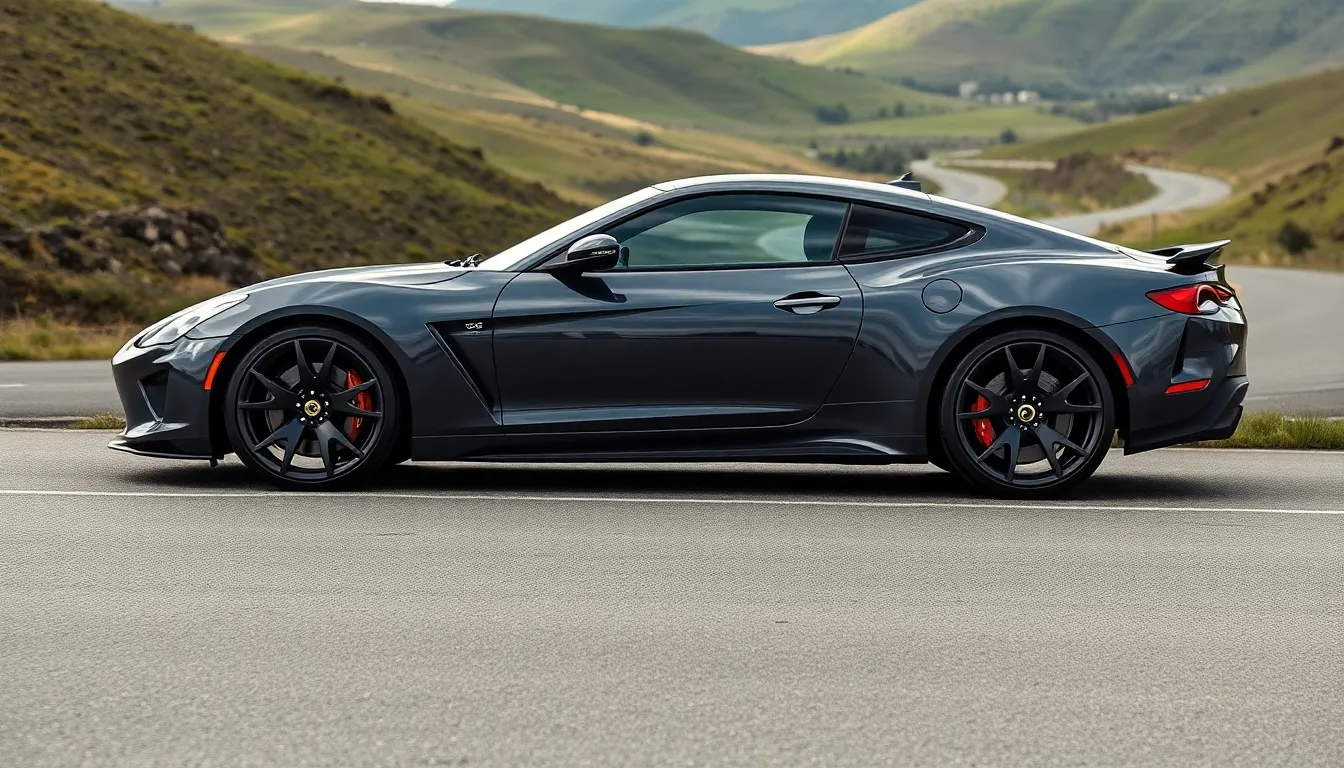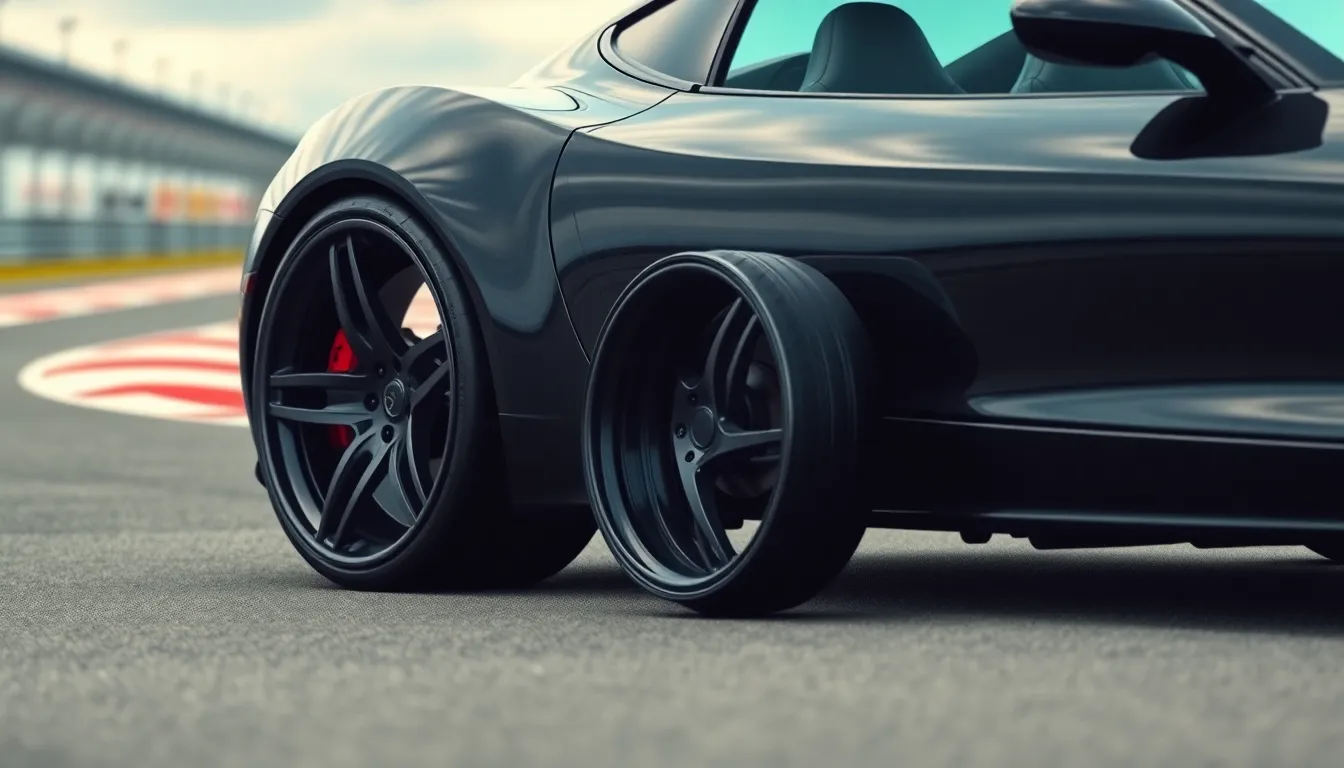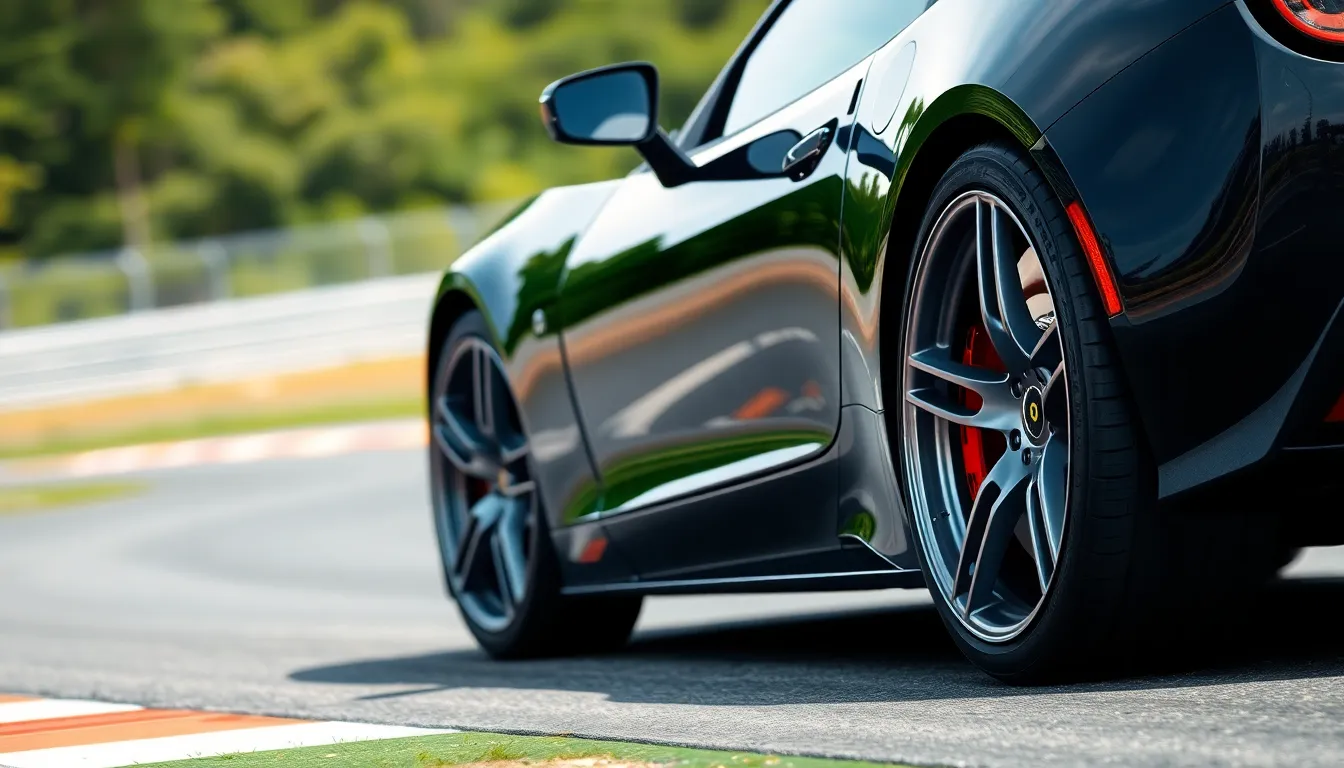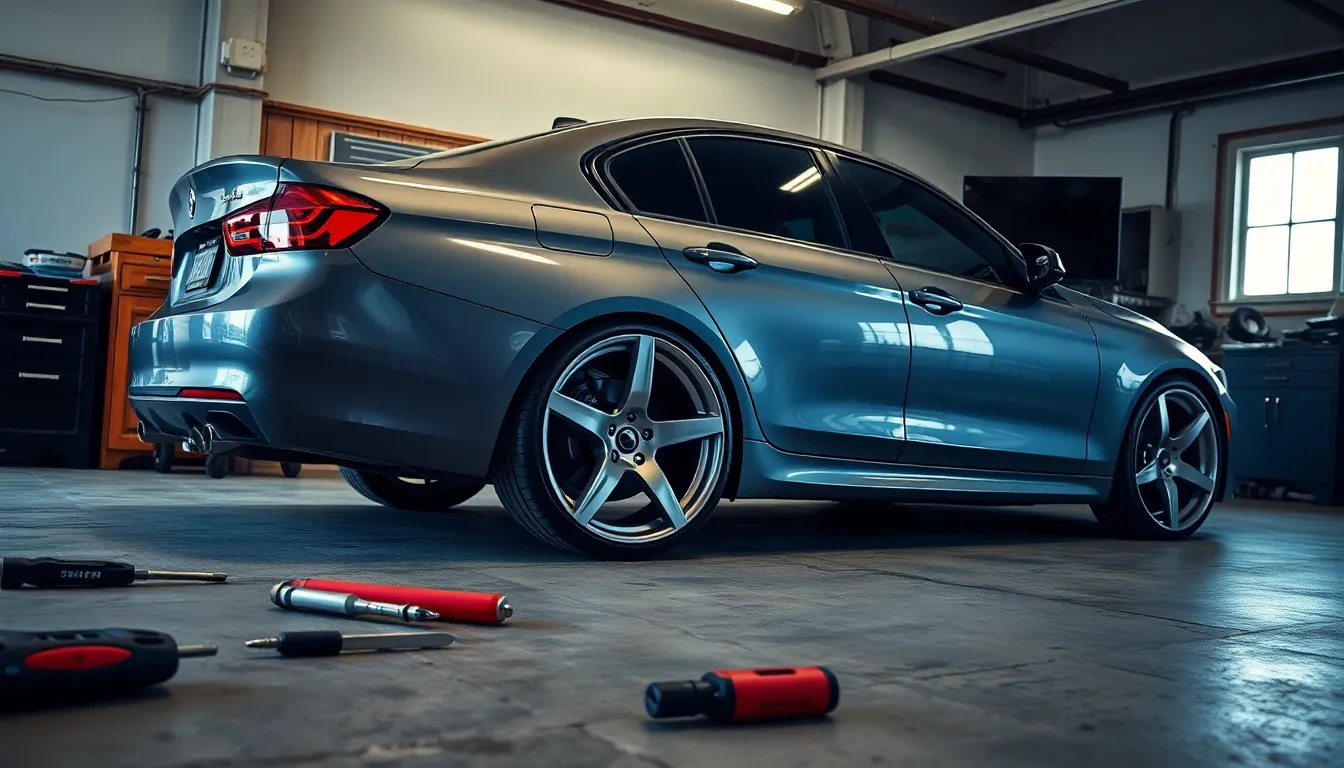When we’re shopping for new wheels or admiring a sleek sports car we often hear the term “staggered wheels” thrown around. But what exactly does this automotive terminology mean and why should we care?
Staggered wheels refer to a wheel setup where the rear wheels are wider than the front wheels on the same vehicle. This isn’t just about aesthetics – though the aggressive stance certainly turns heads. We’re talking about a performance-oriented configuration that can dramatically impact how your car handles corners grips the road and delivers power.
Whether you’re considering upgrading your ride or simply curious about automotive engineering we’ll break down everything you need to know about staggered wheel setups. From the technical benefits to potential drawbacks we’ll explore why many performance enthusiasts swear by this configuration and whether it’s right for your driving style.
What Are Staggered Wheels?
Staggered wheels feature rear wheels that are wider than front wheels on the same vehicle. This configuration creates a distinctive visual appearance while delivering measurable performance benefits that distinguish it from standard wheel setups.
The width difference between front and rear wheels typically ranges from 0.5 to 2 inches depending on vehicle type and intended use. Sports cars like the BMW M3 often run 255mm front tires with 275mm rear tires, creating a 20mm stagger that enhances both aesthetics and handling characteristics.
Modern staggered setups extend beyond width differences to include diameter variations. Many performance vehicles combine 18-inch front wheels with 19-inch rear wheels, optimizing the contact patch distribution for improved traction and cornering stability.
We see three primary staggered wheel configurations in today’s automotive market:
- Width-only stagger maintains identical diameters while varying rim widths
- Diameter-only stagger keeps widths constant but changes wheel sizes
- Combined stagger incorporates both width and diameter differences for maximum effect
Manufacturers like Porsche, Mercedes-AMG, and Corvette use factory staggered setups on their high-performance models. These OEM configurations undergo extensive testing to ensure optimal weight distribution, handling balance, and tire wear patterns across different driving conditions.
Aftermarket staggered wheels allow drivers to customize their vehicle’s appearance and performance characteristics. Popular combinations include 8.5-inch front wheels paired with 9.5-inch rear wheels, or 9-inch fronts matched with 10-inch rears for aggressive street applications.
The staggered concept originated in racing where engineers discovered that wider rear wheels improved power delivery and cornering exit speeds. This racing technology eventually migrated to street vehicles, becoming a standard feature on many sports cars and luxury performance sedans.
Benefits of Staggered Wheel Setups

Staggered wheel configurations deliver three distinct advantages that make them popular among performance enthusiasts and manufacturers alike. These benefits range from measurable performance improvements to enhanced visual appeal.
Enhanced Vehicle Performance
Staggered wheels optimize vehicle performance by maximizing tire contact patches where they’re needed most. The wider rear wheels create a larger surface area between tire and road, which translates to improved power delivery during acceleration. Rear-wheel-drive sports cars like the BMW M3 Competition, Chevrolet Corvette, and Porsche 911 Carrera use this configuration to manage high torque outputs more effectively. Performance vehicles benefit from enhanced stability during high-speed maneuvers, as the wider rear stance provides a more planted feel. Weight distribution improves when larger rear wheels complement the vehicle’s natural balance, particularly important for cars with rear-mounted engines or rear-heavy configurations.
Improved Traction and Handling
Staggered setups enhance cornering capabilities by providing additional grip at the rear axle during critical driving situations. The wider rear tires offer superior traction when accelerating out of turns, reducing the likelihood of power oversteer in rear-wheel-drive vehicles. Handling characteristics become more predictable as the increased rear grip helps maintain stability during aggressive driving. Sports cars equipped with staggered wheels demonstrate better control during lane changes and emergency maneuvers compared to square setups. The configuration allows drivers to exploit the full potential of their vehicle’s power delivery system while maintaining safety margins.
Aesthetic Appeal
Staggered wheels create an aggressive, purposeful stance that distinguishes performance vehicles from standard configurations. The wider rear track generates a muscular appearance that enthusiasts associate with high-performance capabilities. Show cars frequently feature staggered setups to achieve the ever-changing visual profile that emphasizes power and athleticism. This aesthetic enhancement complements the functional benefits, making staggered wheels attractive to both performance-focused and style-conscious drivers. The visual impact stems from the pronounced wheel well fill and the subtle rake that wider rear wheels create when viewed from the side.
Common Staggered Wheel Configurations

Different vehicle types and driving applications use exact staggered wheel configurations to optimize performance and handling characteristics. These configurations vary based on the vehicle’s drivetrain layout and intended use.
Front vs Rear Width Differences
Rear wheels typically measure 1 to 2 inches wider than front wheels in most staggered configurations. This width difference creates the optimal balance between front end steering response and rear axle traction for performance driving scenarios.
Sports cars commonly feature an 8-inch front wheel paired with a 9.5-inch rear wheel, providing the foundation for enhanced cornering stability. High-performance vehicles often use more aggressive configurations with 9-inch front wheels matched to 10.5-inch rear wheels for maximum grip potential.
The width differential serves exact purposes across different drivetrain configurations. Rear-wheel drive vehicles like the BMW M3 Competition benefit from increased rear contact patches that improve power delivery and cornering exit speeds. Front-wheel drive drag racing applications reverse this concept by utilizing wider front wheels to maximize launch traction.
Popular Size Combinations
| Front Width | Rear Width | Vehicle Application |
|---|---|---|
| 8 inches | 9.5 inches | Entry-level sports cars |
| 9 inches | 10.5 inches | High-performance vehicles |
| 10 inches | 11.5 inches | Track-focused supercars |
Manufacturers carry out these combinations based on exact performance targets and vehicle weight distribution requirements. The Chevrolet Corvette utilizes factory staggered setups that complement its rear-biased weight distribution and rear-wheel drive configuration.
European performance vehicles like the Porsche 911 Carrera employ carefully calculated width differences that enhance their renowned handling balance. These configurations optimize the relationship between front end precision and rear axle stability during aggressive driving maneuvers.
Track-oriented vehicles often feature the most extreme width differences to maximize cornering performance and straight-line stability. Racing applications may use even larger differentials depending on tire regulations and exact track requirements.
Vehicles That Use Staggered Wheels

Staggered wheel configurations appear across multiple vehicle categories, with manufacturers implementing these setups to enhance both performance and visual appeal. Sports cars, luxury vehicles, and specialty models benefit from the improved traction and handling characteristics that staggered wheels provide.
Sports Cars and Performance Vehicles
Performance vehicles rely on staggered wheel setups to maximize their handling capabilities and acceleration potential. BMW M3 Competition models feature wider rear wheels that deliver enhanced grip during high-speed cornering and power delivery. Chevrolet Corvette configurations use this setup to optimize weight distribution and improve traction where the engine sends power to the road.
Porsche 911 Carrera models demonstrate how manufacturers integrate staggered wheels into their design philosophy for superior driving dynamics. These sports cars benefit from improved rear traction during acceleration phases and enhanced cornering stability through turns. Racing-derived technology influences these configurations, translating track-tested performance advantages into street-legal applications.
Track-focused vehicles often feature more extreme width differences to maximize contact patches and cornering performance. European performance manufacturers commonly carry out staggered setups as standard equipment rather than optional upgrades. These configurations complement the rear-wheel-drive architecture by placing wider tires where the vehicle delivers its power.
Luxury Sedans and Coupes
Luxury vehicle manufacturers incorporate staggered wheels to combine performance benefits with refined aesthetics and enhanced driving feel. Premium sedans and coupes use these configurations to improve vehicle stance while maintaining the sophisticated appearance expected in luxury segments. Mercedes-AMG and BMW luxury models often feature staggered setups that enhance both visual appeal and driving dynamics.
High-end coupes benefit from the improved weight distribution that staggered wheels provide, creating better balance during spirited driving situations. Luxury manufacturers design these configurations to complement advanced suspension systems and performance-oriented powertrains. The wider rear wheels create an aggressive stance that distinguishes luxury performance vehicles from standard models.
Some front-wheel-drive specialty models like the Pontiac Grand Prix GXP employ staggered configurations even though their less common application in this drivetrain layout. Drag racing applications sometimes use staggered setups on front-wheel-drive platforms to optimize weight transfer and traction characteristics during acceleration runs.
Drawbacks and Considerations

Staggered wheel setups present several important challenges that vehicle owners must evaluate alongside their performance benefits. Understanding these limitations helps us make informed decisions about whether staggered configurations align with our driving needs and maintenance preferences.
Tire Rotation Limitations
Staggered wheel configurations restrict tire rotation patterns to side-to-side movement only, preventing front-to-rear rotation due to size differences between axles. This limitation significantly impacts tire longevity, as traditional rotation patterns distribute wear more evenly across all four tires. We can only rotate tires laterally on the same axle, which means front tires wear differently from rear tires throughout their lifespan.
Uneven tire wear becomes more pronounced with staggered setups, particularly affecting the wider rear tires that experience different stress patterns during cornering and acceleration. Performance vehicles like the BMW M3 and Porsche 911 often require more frequent tire replacements due to these rotation restrictions. The inability to redistribute wear patterns across all four positions typically reduces overall tire life by 15-25% compared to uniform wheel setups.
Cost Implications
Staggered wheel setups require purchasing different tire sizes for front and rear axles, substantially increasing replacement costs compared to uniform configurations. We face higher expenses when replacing tires, as we must buy exact sizes rather than purchasing four identical tires at potentially discounted rates. Premium performance tires in staggered configurations often cost 20-30% more than standard setups due to specialized sizing requirements.
Availability challenges further compound cost considerations, as exact tire models may have limited stock in required stagger sizes. Luxury and performance vehicles with factory staggered setups, such as the Chevrolet Corvette, often require specialized tires that command premium pricing. Emergency tire replacement becomes more expensive when we need exact front or rear sizes that aren’t readily available at standard tire retailers.
Ride Quality Impact
Staggered wheel configurations can negatively affect ride comfort due to the stiffer sidewalls and larger contact patches of wider rear tires. The enhanced performance characteristics that benefit high-speed handling often translate to a harsher ride quality during everyday driving conditions. We experience increased road noise and vibration transmission, particularly noticeable on rough pavement or urban streets with frequent surface irregularities.
Performance-oriented staggered setups prioritize handling precision over comfort, creating a trade-off that affects daily driving enjoyment. The wider rear tires with lower sidewall profiles transmit more road imperfections to the cabin, resulting in a firmer and less compliant ride. Vehicles equipped with staggered wheels typically require more frequent suspension adjustments and may experience accelerated wear on suspension components due to the altered dynamics and increased road feedback.
Staggered vs Non-Staggered Wheels

Staggered wheel configurations differ significantly from non-staggered setups in both design approach and performance characteristics. Non-staggered wheels, also known as square setups, maintain identical dimensions across all four corners of the vehicle. These uniform configurations provide balanced handling characteristics and simplify maintenance requirements for most standard vehicles.
Staggered wheel configurations feature distinct front and rear specifications:
- Front wheels use narrower widths and smaller contact patches
- Rear wheels incorporate wider dimensions for enhanced traction
- Diameter differences may complement width variations in advanced setups
- Performance benefits target acceleration and cornering capabilities
Non-staggered wheel systems offer different advantages:
- Identical wheel dimensions across all four positions
- Uniform tire wear patterns throughout the vehicle’s lifespan
- Simplified tire rotation procedures and maintenance schedules
- Balanced handling characteristics for everyday driving conditions
Performance vehicles like the BMW M3 Competition and Porsche 911 Carrera use staggered configurations to maximize power delivery and cornering grip. These high-performance applications prioritize traction enhancement over maintenance convenience. The wider rear wheels accommodate larger tire contact patches, improving acceleration performance in rear-wheel-drive applications.
Standard vehicles typically employ non-staggered setups because they provide consistent handling balance and reduced maintenance complexity. Equal tire sizes across all positions allow for complete tire rotation, extending overall tire life and maintaining uniform tread wear patterns. This approach suits daily driving requirements where balanced performance takes precedence over maximum traction optimization.
Maintenance considerations distinguish these two approaches significantly. Staggered configurations require purchasing different tire sizes for front and rear positions, increasing replacement costs and limiting rotation options to side-to-side movement only. Non-staggered setups enable full cross-rotation patterns, maximizing tire longevity and maintaining consistent performance characteristics throughout the tire’s service life.
| Configuration Type | Front Wheels | Rear Wheels | Tire Rotation | Maintenance Complexity |
|---|---|---|---|---|
| Staggered | Narrower width | Wider width | Side-to-side only | Higher |
| Non-staggered | Uniform size | Uniform size | Full cross-pattern | Lower |
Installation and Maintenance Tips

Compatibility verification forms the foundation of successful staggered wheel installation. We must confirm that your vehicle’s suspension system and drivetrain accommodate this configuration before proceeding. All-wheel drive and front-wheel drive vehicles typically cannot safely support staggered setups due to differential strain and handling complications.
Manufacturer specifications provide the critical parameters for safe staggered wheel combinations. The size difference between front and rear wheels must remain within recommended ranges to prevent handling issues and premature tire wear. BMW M3 Competition models, for example, use factory-specified size differences that optimize performance without compromising safety.
Professional alignment becomes essential after staggered wheel installation. We recommend scheduling alignment services immediately following installation to prevent uneven tire wear patterns. Suspension settings may require adjustment to accommodate the new wheel configuration and maintain proper vehicle geometry.
Tire rotation limitations significantly impact maintenance schedules for staggered setups. Standard front-to-back rotation patterns become impossible, restricting movement to side-to-side only. Rear tires typically experience 15-25% faster wear rates compared to front tires, particularly on performance vehicles and heavy cars.
Regular inspection protocols help maximize tire life and safety. We advise checking tread depth and tire pressure more frequently than standard configurations. Staggered tires often wear unevenly across different wheel positions, requiring closer monitoring to identify wear patterns early.
Balanced setup considerations ensure optimal vehicle performance and safety. The aesthetic appeal of aggressive staggered configurations must not override functional requirements. Porsche 911 Carrera and Chevrolet Corvette models demonstrate how manufacturers balance appearance with performance through carefully engineered staggered specifications.
Maintenance cost planning accounts for the unique requirements of staggered wheel systems. Different tire sizes for front and rear axles increase replacement costs and may limit availability options. We recommend budgeting for more frequent rear tire replacements and maintaining spare tire compatibility with your staggered configuration.
Conclusion
Staggered wheels represent a sophisticated approach to vehicle customization that balances performance enhancement with visual appeal. We’ve explored how this configuration delivers tangible benefits for handling and traction while creating that distinctive aggressive stance many enthusiasts seek.
The decision to upgrade to staggered wheels eventually depends on your priorities and driving needs. While the performance advantages are clear particularly for rear-wheel-drive sports cars the added maintenance complexity and costs require careful consideration.
Whether you’re looking to maximize your vehicle’s cornering capabilities or simply want that head-turning aesthetic staggered wheels offer a proven solution. We recommend consulting with professionals to ensure compatibility and proper installation for optimal results and safety.
Frequently Asked Questions
What are staggered wheels?
Staggered wheels are a configuration where the rear wheels are wider than the front wheels, typically with a width difference ranging from 0.5 to 2 inches. This setup enhances both vehicle aesthetics and performance by improving cornering, grip, and power delivery. Modern staggered configurations may also include diameter variations, combining different wheel sizes front and rear.
What are the main benefits of staggered wheel setups?
Staggered wheels offer three primary advantages: optimized performance through maximized tire contact patches, improved traction and handling capabilities, and enhanced aesthetic appeal. They help distribute power more effectively, improve cornering exit speeds, and create a distinctive visual appearance that distinguishes the vehicle from standard wheel configurations.
Which vehicles commonly use staggered wheel configurations?
High-performance sports cars like the BMW M3, Porsche 911, Mercedes-AMG models, and Corvette frequently feature factory staggered setups. Luxury performance sedans also utilize these configurations to combine performance with refined aesthetics. Some specialty front-wheel-drive models may also employ staggered wheels to optimize traction and handling characteristics.
What are the disadvantages of staggered wheels?
Staggered wheels present several challenges including limited tire rotation options (side-to-side only), leading to uneven wear and 15-25% reduced tire life. They increase replacement costs due to different tire sizes, complicate tire availability, and may negatively impact ride quality with stiffer sidewalls and increased road noise affecting daily driving comfort.
Can I rotate tires with a staggered wheel setup?
With staggered wheels, tire rotation is restricted to side-to-side movement only, unlike standard setups that allow full rotation patterns. This limitation leads to uneven tire wear patterns and potentially shorter tire life. Regular monitoring of tread depth and tire pressure becomes essential to manage the unique wear characteristics of staggered configurations.
Are staggered wheels suitable for all-wheel drive vehicles?
Not all vehicles can safely support staggered wheel setups. All-wheel drive and some front-wheel drive vehicles may not be compatible with staggered configurations due to drivetrain requirements. It’s crucial to verify compatibility with your vehicle’s suspension and drivetrain systems and consult manufacturer specifications before installation to ensure safety and optimal performance.

